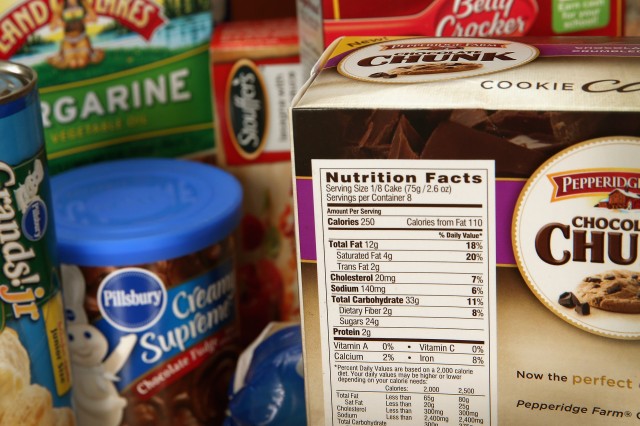Clik here to view.

Photo: Scott Olson / Getty Images
Reading a food label is turning into a job worthy of Britain’s Bletchley Park World War II code breakers. OK, so the situation probably isn’t that dire, but with companies able to make unregulated claims or slip in ingredients provided they do not meet a maximum per serving threshold, it can be difficult to decipher what is actually in our food. When someone isn’t obsessed with health and nutrition, the situation becomes trickier, since “buzzwords” are often misleading. As a result, finding the best option may not come from carefully parsing each line of a product’s nutrition label so much as learning how to avoid being duped by the manufacturer.
The “free” fake-out
A report by Packaged Facts found that avoiding ingredients is a trend the food industry is capitalizing on. In Food Formulation Trends: Ingredients Consumers Avoid, the food and beverage market researcher says that this new lifestyle choice of avoiding certain ingredients is driving our dietary and economic choices. “This is not about dealing with specific allergies but rather a matter of optimizing health and also about seeking to create a quality of life based on eliminating negatives,” Packaged Facts research director David Sprinkle said in a press release. To eliminate those negatives, consumers are looking for the sugar-free, gluten-free, fat-free, and salt-free options.
There are loopholes to be wary of here, too. According to the American Heart Association, for a food to carry the label “sugar-free,” it needs to contain less than 0.5 grams of sugar per serving, and “fat-free” foods can have up to 0.5 grams of fat per serving. “Sodium-free” needs to have less than 5 milligrams of sodium in a serving, and the ingredients cannot have any sodium chloride. All of this matters because it means we are not actually avoiding the foods and ingredients we think we are. Even trans fats can be in a product, provided they too do not exceed the 0.5 gram per serving maximum. If a product lists “partially hydrogenated oil,” it still contains trans fat in each serving. But avoidance food labels aren’t the only packaging that is deceptive or trendy.
Not so natural
In mid-June, Consumer Reports launched a campaign to stop the term “natural” from appearing on packaged food. The call for the ban began after the Consumer Reports National Research Center surveyed 1,000 people and found that around 60 percent of Americans are seeking out foods with the “natural” label because they believe it is the better choice. When a food claims to be “natural,” two-thirds of those surveyed indicated that they think it will not contain any genetically modified organisms, artificial ingredients, or pesticides.
“Our findings show consumers expect much more from the ‘natural’ food label,” said Urvashi Rangan, executive director of the Food Safety and Sustainability Center at Consumer Reports, in a press release. “It’s misleading, confusing, and deceptive.”
The consumer is expecting more and being deceived because the Food and Drug Administration (FDA) does not police the term. In fact, the FDA does not even define what a “natural” food is. “From a food science perspective, it is difficult to define a food product that is ‘natural’ because the food has probably been processed and is no longer the product of the earth,” the FDA said in order to explain why the agency “has not developed a definition for use of the term natural or its derivatives.”
On the one hand, it is a fair point for the FDA to make that a processed food does inherently have unnatural qualities about it. But with food trends shaping our diets, it is also fair to call for an end to a term that has been positively spun by marketers to influence our consumption habits.
The whole picture
“Whole grain” foods are on murky footing, as well. It turns out that there is no clear definition for when a product does or does not fall into the whole grain category, causing the Whole Grains Council to take matters into its own hands: It created a literal stamp of approval for products that meet its definition. The FDA has been reviewing guidelines on this matter since 2006, and the Council worries that if the definition established by the American Association of Cereal Chemists (AACC) International is used as the standard, products with more refined grain than whole grain could bear the whole grain label, misleading consumers.
If the Whole Grains Council’s worries are correct, it would be a continuation of the current state of affairs. The Cancer Nutrition Centers of American says that in order to ensure your product really does have more whole than refined grain, you need to look at the ingredient list to see if “whole grain” or “whole wheat flour” are dominant ingredients.
Considering taking the easy way out and just relying on the calorie count? The situation isn’t any clearer there, either. The FDA allows for a 20 percent margin of error when a manufacturer calculates the number of calories in each serving. In 2010, researchers at Tufts University analyzed frozen meals, discovering that on average, the item contained 8 percent more calories that what was advertised.
The lackadaisical regulation of terms and carefully designed marketing ploys mean that food product labels can be a less than helpful tool. Always check for partially hydrogenated oils, see if refined grains are listed, and learn the words that conceal sugars, like galactose.
More From Wall St. Cheat Sheet:
- How to Find the Healthiest Meals in the Frozen Food Aisle
- Why a Healthy Brain Requires Taking Care of Your Heart
- Caffeine Cheat Sheet: What You Need to Keep Your Habit Healthy
Want more great content like this? Sign up here to receive the best of Cheat Sheet delivered daily. No spam; just tailored content straight to your inbox.
Read the original article from The Cheat Sheet